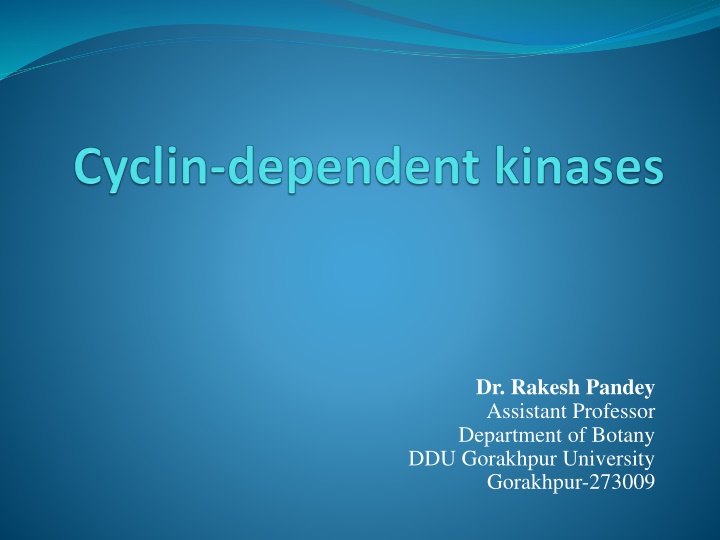
Regulation of Cell Cycle by Protein Kinases and Cyclins
Explore the intricate mechanisms of cell cycle regulation through the collaboration of protein kinases and cyclins. Learn how cyclin-dependent kinases (CDKs) and cyclins orchestrate the progression of the cell cycle stages with precise coordination and fluctuating concentrations. Discover the essential role of cyclins in substrate determination and the regulation of CDK activity. Dive into the dynamic interplay between cyclin and CDK combinations at different phases of the cell cycle, elucidating the crucial control mechanisms that drive cellular division forward.
Download Presentation

Please find below an Image/Link to download the presentation.
The content on the website is provided AS IS for your information and personal use only. It may not be sold, licensed, or shared on other websites without obtaining consent from the author. If you encounter any issues during the download, it is possible that the publisher has removed the file from their server.
You are allowed to download the files provided on this website for personal or commercial use, subject to the condition that they are used lawfully. All files are the property of their respective owners.
The content on the website is provided AS IS for your information and personal use only. It may not be sold, licensed, or shared on other websites without obtaining consent from the author.
E N D
Presentation Transcript
Dr. Rakesh Pandey Assistant Professor Department of Botany DDU Gorakhpur University Gorakhpur-273009
Regulation of cell cycle is done by protein kinases. These protein kinases are heterodimers i.e. made up of twodifferent subunits. One subunit has kinase property i.e. it can phosphorylate several protein molecules at specific regulatory sites. This is the catalytic subunit of protein kinase. This subunit is known as Cyclin-dependent kinase or CDK. The other subunit has regulatory function and is known as Cyclin.
Because catalytic subunits cannot work without cyclins, these are called cyclin dependent kinases. Cyclins provide substrate Cyclin-CDK complexes, i.e. determine which substrate to be phosphorylated by the kinase. specificity to Each CDK can form active complex with different cyclin subunits.
Cyclins are phase specific and one particular type of cyclin is present during the phase it promotes e.g. G1 and G1/S phase cyclins are present in G1 phase, S phase cyclins are present during the S phase. When a particular cyclin level decreases, the activity of corresponding protein kinasealso decreases. Three common classes of cyclins exist on the basis of their presence at a particular stage- G1 and G1/S phase cyclins S- phase cyclins M- phase cyclins
Image showing fluctuations in CDKs activity due to changing concentrations of cyclins (Lodish et al. 2016, Molecular Cell Biology)
The concentration of cyclins fluctuate during the cell cycle and this fluctuation is responsible for the progression of cell cycle through different stages. There are four diffferent types of CDKs- CDK1, CDK 2,CDK4 and CDK6 involved in cell cycle. CDK4 and CDK6 are G1 phase CDK, CDK2 is G1/S phase and S phase CDK, and CDK1 is mitotic CDK i.e. M phase CDK. Activity of CDK is regulated by cyclin binding and T- loop phosphorylation of CDK.
Image showing cyclin and CDK combinations at different stages of cell cycle ( Lodish et al. 2016, Molecular Cell Biology)
Cyclins are degraded by ubiquitin mediated protein degradation process. Two types of ubiquitin protein ligases ubiquitinylate protein substrates for degradation. These are SCF (Skp1, Cullin, and F- box proteins) and APC/C (Anaphase promoting complex or cyclosome). CDKs are not only regulated by cyclin binding but also by phosphorylation of catalytic subunit. Phosphorylation near active site by CDK- activating kinase (CAK) promotes activity of CDKs. Phosphorylation in ATP binding pocket of CDK inhibits kinase activity.
References- Lodish et al. 2016, Molecular Cell Biology, W. H. Freeman and Company, Newyork. Disclaimer- The content is prepared only for educational purposes.
Disclaimer- This content is prepared for educational purposes only.
